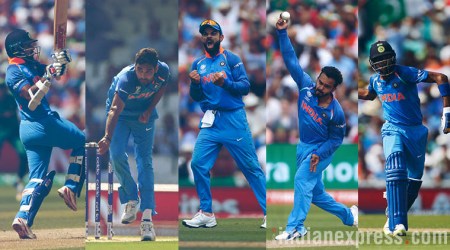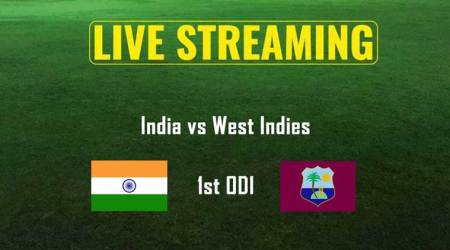 It’s a tribute to Anil Kumble that such sentiments have been whipped up. (Source: Reuters)
It’s a tribute to Anil Kumble that such sentiments have been whipped up. (Source: Reuters)
There is an understandable swell of sympathy regarding Anil Kumble’s decision to discontinue as India coach. His past as a match-winner, his good win-loss record as a coach, and the manner in which his tenure was cut short after misunderstandings with captain Virat Kohli and a few senior players has earned him support. Visuals of him mopping around alone on the dressing room balcony during India’s loss against Pakistan only accentuated those sentiments.
It’s a tribute to Kumble that such sentiments have been whipped up. For last year, when Ravi Shastri was replaced by the Cricket Advisory Committee (CAC) despite doing a stellar job of inspiring a young team and being backed by the captain and many in the team, there wasn’t much public support or sympathy.
Any whispers of dissent that emerged were immediately hushed and shot down by the choice of someone of Kumble’s stature. As soon as his name came up, the Shastri file was closed without much of a post mortem.
But it deserves a little rewind now as it’s the past that shapes the present, and will colour the future. Kohli was captain but his choice seemingly didn’t matter then. Neither did the voices of support for Shastri that bubbled up from a few senior players. It was a choice that was foisted from above on the players. In their playing days, the CAC members — Sachin Tendulkar, Sourav Ganguly and VVS Laxman — chose or influenced the coach but weren’t willing to give the current lot the same courtesy.
Not that the choice of Kumble was unanimous then. It took a vote from Laxman to break the deadlock after Tendulkar and Ganguly chose Shastri and Kumble respectively. The Indian cricket board slipped up even at that juncture. They sensed the mood of the team and the way the Kumble decision was made and came up with a silly compromise: Have Shastri as an assistant coach to Kumble, a decision that was rejected by all parties concerned. Just imagine the groupism that would have kicked in with multiple power centres. In the end, the captain’s preference was overlooked, and Kumble took over.
It was a decision against two characters: Despite the performances under him, Shastri wasn’t seen as a serious coach who could responsibly mentor and guide a team. And despite his stated preference, Kohli wasn’t to be given untrammelled power and his man alongside him.
With Shastri at the helm, stereotypes took over: oh, a boisterous fun-loving personality like him might not be ideal for a young captain and a team.
It was forgotten that Shastri was a player who overcame his limitations with bloodymindedness and ambition and that he could pass those traits to the current Indian team. It was a pity that Shastri’s man Bharat Arun, the bowling coach, also had to lose out as most player reports about him were pretty laudatory.
With Kumble in, stereotypes ruled again: that a determined player who shrugged off conventional wisdom to achieve what he did can inspire and discipline a team to great heights. There was nothing wrong in that assessment, but sometimes things just don’t go the way one thinks they would. A captain already a touch wary about the new man in charge, and a coach, a strong individual who has been captain and commanded respect from cricketers around the world, began their collision in slow motion.
Reports are varied about the origin of misunderstanding: it’s been said it was from the IPL days, issues over team selection in West Indies, and even during the home series against England and Australia. Occasionally, it was about the coach backing a particular player, at times it has been the captain’s choice of players, and once it was about a player being pushed to prepare for longer hours than he was prepared for — from outside, all this might seem usual grist to the mill that would happen even in a school team when different individuals come together. But obviously, things have a way of spiralling out of control in the adult world. Considering that the CAC decided to go for Kumble again, one can only assume they did a proper check and found there wasn’t any insurmountable issue.
The board, which is supposed to run its usual checks and balances with the manager’s reports after every series and what not, could have done a far better job in stubbing out the misunderstanding before it became untenable.
Kumble’s resignation letter too was an extraordinary statement in itself, claiming all the virtues and goodness for himself, leaving little to doubt about what he really thinks about Kohli. It also claimed that he wasn’t told by BCCI till a day ago that the captain had an issue with him — which in itself is a statement on how far the relationship between the two had gone sour. It doesn’t reflect well on the coach to claim that he was unaware of the feelings in the team about him — after all, he is supposed to know the pulse of the team.
In popular perception, it has come down to Kumble vs Kohli but it can be said here that a few other players had raised doubts about Kumble in private.
The criticism wasn’t always about him being intimidating, but about the way, he reacted to match situations. Perhaps, the body language was misinterpreted by the players who made a wrong assessment — whatever be the case, what can be done when the players feel a level of discomfort and disconnect with the coach? As Shastri would have said on air, something’s gotta give — and it’s not a surprise that the relationship between the coach and a few players began to break down.
When the dust settles down, Kumble’s legacy as a coach can be seen in a better light. The successful comeback story of Cheteshwar Pujara, who was given confidence and support to forget all the silly brouhaha over his strike rate, would feature at the top of his achievements.
While a couple of players might not have appreciated the gruelling sessions administered at the insistence of Kumble, they would perhaps come around in time to acknowledge the improvement in their games.
The entire episode brings a greater focus on Kohli. It might seem as if he has got his way now, but it only puts a great deal of pressure on him. Speculation is bound to rise with the Board deciding to call in for more applications: Does that mean Virender Sehwag isn’t a shoe-in anymore? Does that mean he too has decided to stay away after the current mess?
He might not have been an Indian captain ever, but Sehwag’s stature and stardom was greater than most Indian cricketers of the past. It would be silly to assume that he would take over and be a mute spectator, especially now when he has built a brand around himself about his outspokenness. Does it mean Shastri can come back as the coach?
What would happen if the captain runs into problems with the new coach, whoever it may be? Would the board appoint a yes-man to appease their captain? This episode gives rise to such speculation. People will question whether Kohli’s ego spilt over too much, and he has to take such accusations on the chin and move on. The choice of the new coach will surely tell us about the direction Kohli and the board want to take the Indian team.

